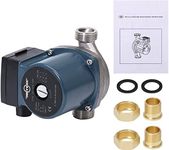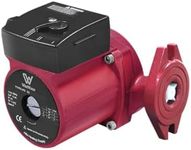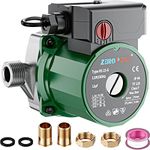Buying Guide for the Best Hot Water Recirculating Pump
Choosing a hot-water recirculating pump can make your home more comfortable and efficient by providing instant hot water at your taps and reducing water waste. The right pump for you depends on your home's plumbing setup, your hot water usage habits, and your preferences for convenience and energy savings. Understanding the key specifications will help you select a pump that fits your needs and ensures reliable performance.Flow RateFlow rate refers to how much water the pump can move in a given amount of time, usually measured in gallons per minute (GPM). This is important because it determines how quickly hot water will reach your faucets. Lower flow rates (around 2-4 GPM) are suitable for smaller homes or single fixtures, while higher flow rates (5 GPM and above) are better for larger homes with multiple bathrooms or long pipe runs. To pick the right flow rate, consider the size of your home and how many fixtures you want to supply with instant hot water.
Pump TypeThere are two main types of hot-water recirculating pumps: dedicated return line pumps and comfort system pumps that use the existing cold water line as a return. Dedicated return line pumps are more efficient and provide faster hot water, but require a separate return pipe, which is usually found in newer homes. Comfort system pumps are easier to install in older homes without a return line but may take slightly longer to deliver hot water. Choose the type that matches your home's plumbing and your installation preferences.
Control OptionsControl options determine how and when the pump operates. Common controls include timers, thermostats, and motion sensors. Timers allow you to set specific times for the pump to run, thermostats activate the pump when water temperature drops, and motion sensors turn the pump on when movement is detected near a fixture. If you want to maximize energy savings, look for pumps with programmable timers or smart controls. If convenience is your priority, motion sensors or thermostatic controls may be a better fit.
Noise LevelNoise level refers to how much sound the pump makes while operating. This is important if the pump will be installed near living spaces or bedrooms. Quieter pumps are generally preferred for indoor installations, while noise may be less of a concern for pumps installed in basements or utility rooms. If you are sensitive to noise or the pump will be close to frequently used rooms, look for models that are specifically designed for quiet operation.
Energy EfficiencyEnergy efficiency describes how much electricity the pump uses to operate. More efficient pumps use less power, which can save you money on your energy bills and reduce your environmental impact. Some pumps have energy-saving features like variable speed motors or smart controls that only run the pump when needed. If you are concerned about ongoing energy costs or want to be environmentally friendly, prioritize pumps with high efficiency ratings or energy-saving features.
Installation RequirementsInstallation requirements refer to what is needed to set up the pump in your home, such as plumbing modifications, electrical outlets, or space for the unit. Some pumps are designed for easy DIY installation, while others may require professional help, especially if a dedicated return line is needed. Consider your comfort level with home improvement projects and the existing plumbing in your home when choosing a pump. If you want a simple installation, look for pumps that are marketed as easy to install or that use your existing plumbing.
















